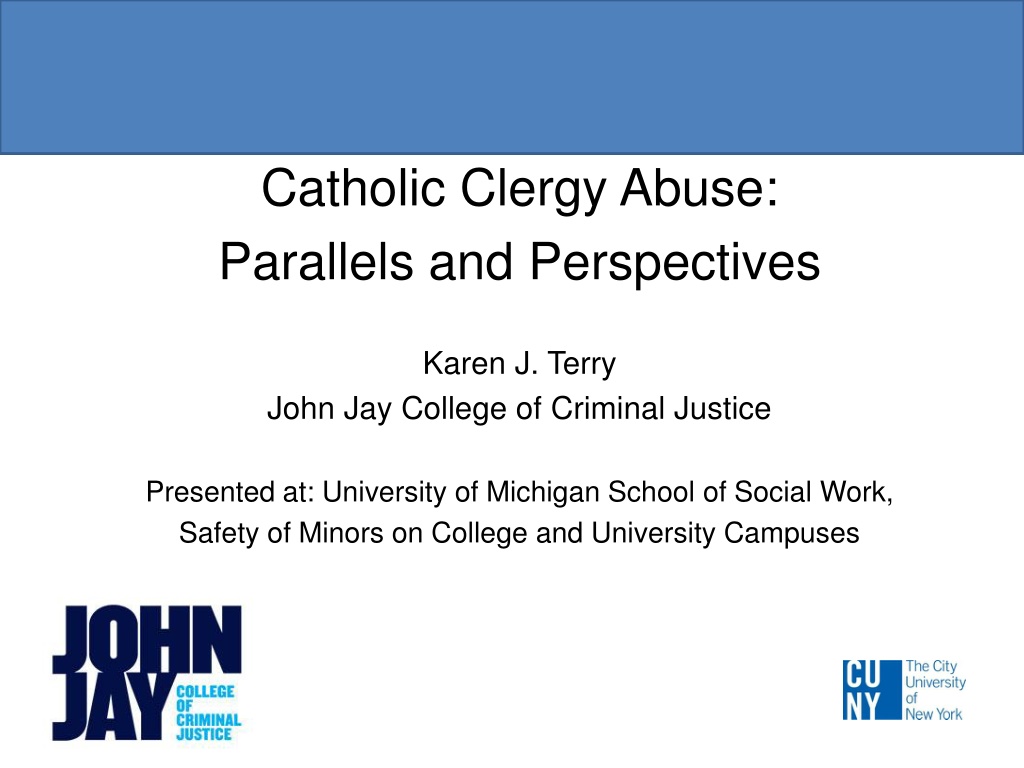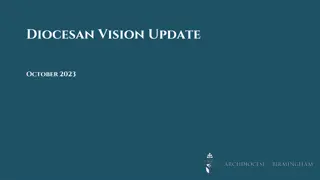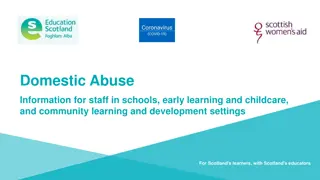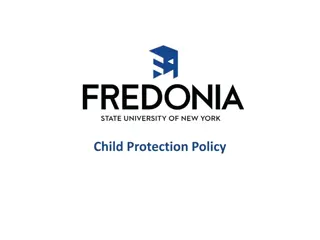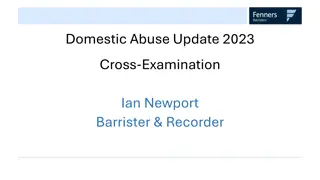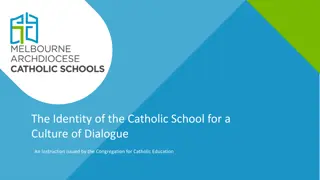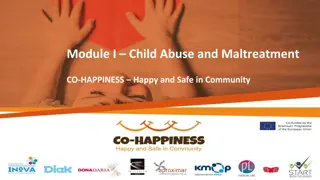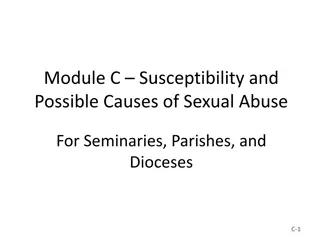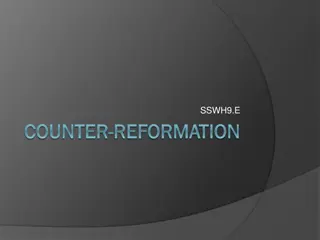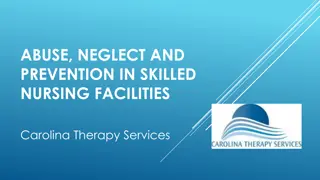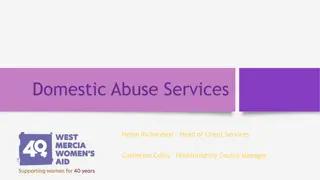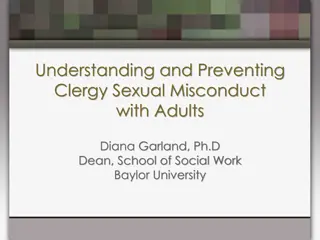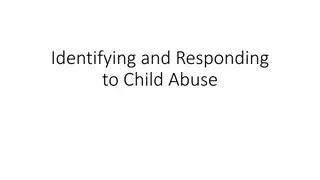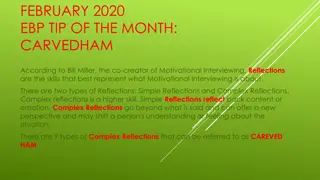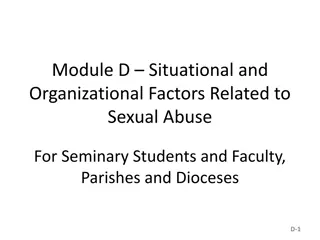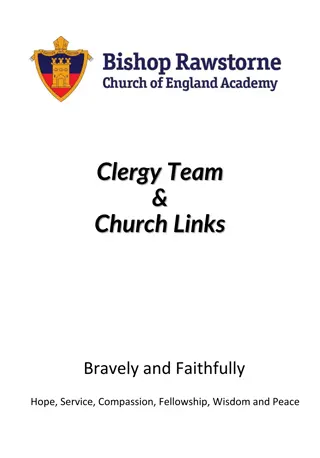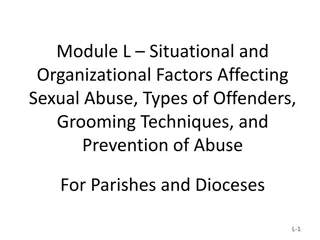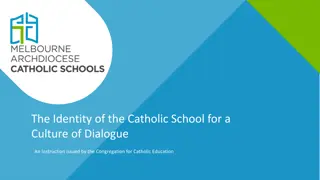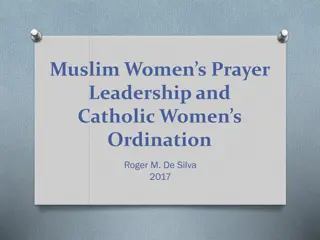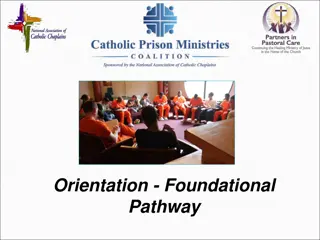Understanding Catholic Clergy Abuse: Insights and Reflections
Explore the prevalence of abuse within institutions and the Catholic Church, with a focus on studies conducted between 1950 and 2002. Delve into the nature and scope of the abuse, its impact on victims and the Church, and key findings regarding the number of abusers and victims. Discover the methodologies used to survey allegations and gain a deeper understanding of this significant issue.
Download Presentation

Please find below an Image/Link to download the presentation.
The content on the website is provided AS IS for your information and personal use only. It may not be sold, licensed, or shared on other websites without obtaining consent from the author. Download presentation by click this link. If you encounter any issues during the download, it is possible that the publisher has removed the file from their server.
E N D
Presentation Transcript
Catholic Clergy Abuse: Parallels and Perspectives Karen J. Terry John Jay College of Criminal Justice Presented at: University of Michigan School of Social Work, Safety of Minors on College and University Campuses
Abuse within Institutions Abuse prevalent in institutions where adults mentor or spend time alone with children and adolescents Two studies on sexual abuse of minors by Catholic priests in the United States Nature and Scope Causes and Context 2
Abuse within the Catholic Church Annual meeting, June 2002 The Charter for the Protection of Children and Young People The Office of Child and Youth Protection The National Review Board Conduct two studies: Nature and Scope understand what happened Causes and Context understand why it happened
Nature and Scope Study Examine the characteristics and extent of allegations of sexual abuse between 1950 and 2002 Collect information about the alleged abusers Collect information about the characteristics of the alleged victims Collect information about the financial impact of the abuse on the Church
Nature and Scope: Methodology Surveyed all dioceses and religious communities about sexual abuse allegations against clerics from 1950 to 2002 Three surveys per diocese A profile of each diocese A survey for each priest with an allegation of abuse in Church files A survey for each individual who made an allegation of abuse against a priest Response rate: 97%
Nature and Scope: Key Findings Number of abusers: 4,392 (approximately 4% of priests in ministry during that time) Consistent across all sizes of dioceses and in all regions (range = 3-6%) Number of victims: 10,667 (has since increased with reports post-2003) Distribution of abuse incidents 1950 2002: Rise in the 1960s, peak in the 1970s/ early 1980s, sharp decline by mid-1980s.
Distribution of Abuse Incidents 1950-2002
Distribution of Abuse Incidents (Count of abuse incidents, JJC & CARA,1950-2002, 2004-2008) 2000 CARA 1800 JJC 1600 1400 1200 1000 800 600 400 200 0 1954 or Earlier 1955-19591960-19641965-19691970-19741975-19791980-19841985-19891990-19941995-19992000-20022004-2008
Nature and Scope: Reports of Abuse, by Year Reported
Characteristics of Priest abusers Most were diocesan priests (approximately two-thirds) and either pastors or associate pastors Range in age from mid-20s (in seminary) to 90 at first incident of abuse Slightly more than half had one allegation of abuse; about one-quarter had 2-3 allegations of abuse 3.5% of priests responsible for approximately 26% of all sexual abuse acts against children ( career criminals ) Most were generalists rather than specialists
Duration of Abusive Behavior (where abuse is more than 1 year) # Victims Mean Length of Abuse (in years) 1.58 7.20 11.90 18.10 22.03 4.99 Range of Duration in years 1-21 1 2-3 4-9 10-19 20+ Overall 1-40 1-41 5-41 1-35 0-41
Nature and Scope: Offender Types
Nature and Scope: Victim Age and Gender
JJC & CARA Data: Victim Age 50.3% 49.7% CARA Totals JJC totals 22.4% 22.1% 16.0% 15.3% 12.3% 11.9% < 9 yrs 10 thru 14 15 thru 17 unknown
JJC & CARA Data: Gender JJC Data through 2002 CARA DATA 2004 -2008 80.9% 79.6% 20.4% 19.1% Male Female
Questions Raised What explained the peak of abuse behavior in the 1970s? Were there factors in society generally, or in the Catholic Church, that led to the increase in abuse incidents? Are priest abusers unique, either to other priests or to non- clergy sexual abusers? Are there risk factors that might identify potential offenders? How has seminary education changed over this time period? What role did the Church leadership play in addressing the abuse crisis, and when? What role did opportunity and situation play in the abusive behavior? Why was the harm of sexual abuse not understood?
Causes and Context: Methodology Collected / analyzed multiple sources of data: Longitudinal analyses of data sets of various types of behavior (for example, crime, divorce, pre-marital sex) (Historical analysis); Analysis of seminary education, history and the development of a human formation curriculum, as well as information from seminary leaders (seminary analysis); Surveys of and interviews with inactive priests with allegations of abuse, and a comparison sample of priests in active parish ministry who had not been accused (identity and behavior survey);
Methodology (cont) Interview and primary data from the 1971 Loyola University study of the psychology of American Catholic priests (baseline study of priests at the peak of the abuse crisis); Surveys of survivors, victim assistance coordinators and clinical files about the onset, persistence and desistance of abuse behavior (victim and situational analysis);
Methodology (cont) Surveys of bishops, priests and other diocesan leaders about the policies that were put in place after 1985; meetings with victim advocates who played a role in responses to the abuse crisis (leadership analysis); and Analyses of clinical data from the files from three treatment centers, including information about priests who abused minors as well as those being treated for other behavioral problems (individual/psychological analysis).
Changes in Abuse Patterns Over Time Identified a seminary cohort effect - differences in the patterns of abuse for men ordained each decade: Time to first incident of abuse 1940s 17 years 1950s 12 years 1960s 8 years 1970s 5 years 1980s 3 years Type/number of victims (e.g., 1940s/1950s generalists , e.g., Father Maciel; 1960s serial predators ) Pre-ordination sexual experience
Seminary Education and Influences Expansion of seminaries post-war Diocesan priests who would later abuse were predominantly trained in major national seminaries Almost all major national seminaries graduated priests who would later abuse minors Priests who attended minor (high school) seminaries not at a significantly higher risk of abusing Evaluated the changes in seminary education over this period of time; significant developments in teachings of human formation (see Sr. Katarina Schuth)
Individual-Level Factors Are clergy with allegations of sexually abusing minors distinguishable from non-abusers based upon: History of sexual abuse Developmental stressors (severe family disruption, i.e., death of a family member) Psychological and/or mental health problems Intimacy deficits (difficulty developing healthy emotional relationships with others) Intelligence Sexual identity and / or pre-ordination sexual behavior
Clinical Data Priests treated for sexual abuse of a minor: More likely to have a history of sexual abuse (significant in one clinical sample) Exhibited intimacy deficits, often emotional congruence with adolescents, and often other problems (e.g., stress, obesity, alcohol, gambling) No more likely that others to have diagnosable psychological disorders 5% clinically diagnosed as pedophiles in two separate clinical samples; abusive priests more likely to be generalists
Psychological Testing Data MCMI: No significant differences were found on any of the scales, which measure personality disorder traits WAIS: No Significant differences in WAIS (IQ) scores were found between the three main treatment groups MMPI: No significant differences on primary scales. The only clinically elevated MMPI subscale that significantly differentiated clergy who abused minors from clergy who had inappropriate relationships with adults was Over-Controlled Hostility
Clinical Data: Sexual Identity/ Behavior Most priests who sexually abused minors also had participated in sexual relationships with adults (80%) Homosexuality and sexual abuse of minors Sexual experience heterosexual or homosexual before ordination predicts sexual behavior after ordination, but with adults not minors Sexual behavior was most often varied (in regard to age and gender) Most incidents of abuse occur before the 1980s when homosexual behavior in seminary reportedly increased Homosexual orientation alone is not a significant predictor of sexual abuse of minors Confused sexual identity critical in 1940s/1950s cohorts
Organizational and Structural Factors: Abuse Organizational factors played a role in abuse opportunities Cultural factors High levels of isolation, discretion Power/authority Little direct supervision Low level of peer support Job-related stress Negative feelings, behaviors Loneliness, lack of intimacy Poor self-care Inappropriate relationships
Organizational and Structural Factors: Responses to Abuse Hierarchical but decentralized organization; much autonomy by diocese Police own bad behavior; little external oversight Similar to other organizations, e.g., police Rotten apples ; Individual, not organizational problem Internal affairs bureaus Lack of transparency in response to complaints Developed external review boards (accountability to the community) Commissions after highly publicized negative events Highlight institutional nature of bad behavior; tolerated by peers, leaders
Leadership Factors Gilbert Gauthe in 1985; led to widespread discussions about sexual abuse of minors by Church leaders By 1985, sexual abuse cases had been reported in slightly more than half of the dioceses Priest Councils or Priest Senates were active participants in the early discussion in two-thirds of the dioceses in the late 1980s Approximately 25% of the dioceses engaged a clinician to help understand the problem Creation of the Five Principles ; published in 1993
The Five Principles (1) Respond promptly to all allegations of abuse where there is reasonable belief that abuse has occurred; (2) If such an allegation is supported by sufficient evidence, relieve the alleged offender promptly of his ministerial duties and refer him for appropriate medical evaluation and intervention; (3) Comply with the obligations of civil law regarding reporting of the incident and cooperating with the investigation; (4) Reach out to the victims and their families and communicate sincere commitment to their spiritual and emotional well-being; and (5) Within the confines of respect for privacy of the individuals involved, deal as openly as possible with the members of the community.
Principles and Practice Positive Reactions to Abuse Discussions: Leadership from Cardinal Bernardin Work of the AdHoc Committee Five Principles created However: Five Principles not implemented consistently across dioceses Lack of consistency in responses to abuse, except for the treatment of the priest (especially in 1990s); little transparency Insiders were engaged, but outsiders were rebuffed; information was tightly controlled.
Failing the Spirit of the Five Principles: 1993 - 2002 Diocesan leaders in many instances failed to meet with victims directly Reports from family members did not result in any follow-up from the diocese Priests were sent for treatment, then returned to ministry; parishes were not notified of the history of abuse Communication with civil authorities only in the most severe cases of repeated abuse Some diocesan leaders who gave testimony under oath in civil cases denied they had knowledge of abuse Focus on priests; lack of recognition of responsibility for harm to victims
Change in Diocesan Practices Change has happened, but slowly Lack of understanding of the timing of abuse incidents (in the 1960s & 1970s) and reports of abuse (in the 1990s and 2000s) complicates diocesan explanations Understanding of the harm of abuse came slowly Delay in appropriate response was pronounced in large and influential dioceses Dioceses must continue to provide for safe environment education, be held accountable, and increase transparency in response to abuse
Parallels Between the Catholic Church and Other Institutions Not just a Catholic problem Abuse occurs in other religions, sports and social organizations, schools Religion: Jewish, Protestant, Southern Baptist, Episcopal, Jehovah s Witnesses and Mormon religions Extent of the abuse is unknown; anecdotally, reports indicate widespread patterns of abuse
Schools and Childcare Settings Shakeshaft report Sexual abuse of children widespread in schools, woefully understudied Teachers most likely to commit abuse were those who spent individual time with the students Finkelhor and Williams Abuse most likely to occur with low staff presence and in informal care settings
Social Organizations Boy Scouts of America, Big Brothers/Big Sisters Boy Scouts released files of approximately 1,800 abusers 1970 1991 Organizational activities provided opportunities for abuse to occur
Sports Organizations University Penn State: Individual (Sandusky) and organizational (administrative) problems National Teams USA Swimming, Hockey, Olympic sports (e.g., weightlifting) Unique mentorship, individual attention, fear of reporting
US Olympic Committee Response Created SafeSport Guidelines, with minimum standards for athlete protection Required all sporting organizations to implement guidelines by December 2013
USOC Minimum Standards Policy for Athlete Protection The athlete safety program shall include, at a minimum, the following components: 1. Prohibited Conduct - A policy which prohibits and defines the six types of misconduct 2. Criminal Background Checks 3. Education and Training 4. Reporting 5. Enforcement
Six Types of Misconduct Addressed by SafeSport Bullying Harassment Hazing Emotional Abuse and Misconduct Physical Abuse and Misconduct Sexual Abuse and Misconduct
Conclusions Situational factors provide opportunity for abuse in institutions with mentoring of adolescents by adults Most organizations have implemented safe environment training programs, but youth are still at risk Cannot eliminate individual mentorship
Conclusions (cont) Lack of timely reporting Repercussions Organizational (e.g., legal, reputation) Individual (e.g., ostracized, leave institution) Shortcomings of background checks, psychological tests Constraints of organizations to respond
Questions Difference in abuse by type of institution How do abusive relationships develop? Do situational factors differ? Role of oversight, organizational and cultural factors? Decrease in sexual abuse since 1990s Effect of safe environment policies on abuse within institutions?
Next Steps: John Jay Researchers Coding BSA files for situational factors Goal: Understand the situations in which positive mentoring relationships developed into abusive relationships Identify high-risk situations, boundary violating behaviors
Thank you Karen Terry John Jay College of Criminal Justice kterry@jjay.cuny.edu
